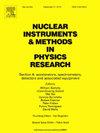基于扫描电子显微镜的高空间分辨率锥束x射线成像系统
IF 1.4
3区 物理与天体物理
Q3 INSTRUMENTS & INSTRUMENTATION
Nuclear Instruments & Methods in Physics Research Section A-accelerators Spectrometers Detectors and Associated Equipment
Pub Date : 2025-08-20
DOI:10.1016/j.nima.2025.170975
引用次数: 0
摘要
利用扫描电子显微镜(SEM)高质量电子束产生的微光斑x射线源,实现了高空间分辨率锥束x射线成像系统。基于Geant4模拟,在一次电子束尺寸为10 nm时,x射线源直径约为1.0 μm,主要由铜靶内的电子注入范围决定,x射线源服从双高斯分布。获得了400目铜网的清晰x射线图像,在放大倍率为68.8的情况下,系统的最佳空间分辨率为7.1 μm。实现了蚂蚁头部不同区域的x射线成像,清晰显示了蚂蚁的下颚和眼睛等器官,且成像范围易于调节。结果表明,该成像系统具有较高的放大倍率和精确的空间分辨率,能够对非常小的生物标本实现清晰实用的x射线成像。本文章由计算机程序翻译,如有差异,请以英文原文为准。
High spatial resolution cone beam X-ray imaging system based on a scanning electron microscope
A high-spatial-resolution cone-beam X-ray imaging system has been realized based on the micro spot X-ray source generated by a high-quality electron beam from a Scanning Electron Microscope (SEM). The diameter of the X-ray source was estimated to be 1.0 μm based on Geant4 simulation when the primary electron beam size is 10 nm, which is mainly determined by the electron injection range inside the copper target, and the X-ray source was found to follow double Gaussian distribution. The clear X-ray images of a 400-mesh copper mesh have been acquired, and the best spatial resolution of the system was tested to be 7.1 μm under magnification factor of 68.8. The X-ray imaging on distinct head regions of a Carebara diversa ant have been realized, the organs like the ant's jaw and eyes were clearly shown, and the imaging range can be adjusted easily. These results demonstrate that this imaging system has high magnifications and precise spatial resolution, and is able to achieve clear and practical X-ray imaging for very small biological specimens.
求助全文
通过发布文献求助,成功后即可免费获取论文全文。
去求助
来源期刊
CiteScore
3.20
自引率
21.40%
发文量
787
审稿时长
1 months
期刊介绍:
Section A of Nuclear Instruments and Methods in Physics Research publishes papers on design, manufacturing and performance of scientific instruments with an emphasis on large scale facilities. This includes the development of particle accelerators, ion sources, beam transport systems and target arrangements as well as the use of secondary phenomena such as synchrotron radiation and free electron lasers. It also includes all types of instrumentation for the detection and spectrometry of radiations from high energy processes and nuclear decays, as well as instrumentation for experiments at nuclear reactors. Specialized electronics for nuclear and other types of spectrometry as well as computerization of measurements and control systems in this area also find their place in the A section.
Theoretical as well as experimental papers are accepted.

 求助内容:
求助内容: 应助结果提醒方式:
应助结果提醒方式:


